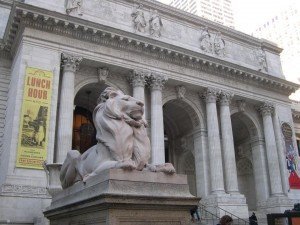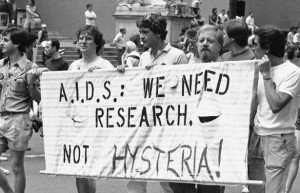Hitler’s occupation of France presented writers with a difficult, often dangerous dilemma: keep silent, collaborate, or resist the Germans and their Vichy allies. A new exhibition at The New York Public Library explores how Sartre, Gide, Cocteau and dozens of other public intellectuals responded to Nazi rule. Personal correspondence, photographs, manuscripts, books and posters —- most displayed for the first time in the United States —- illustrate the contrasting, often complex response by writers to the country’s defeat and the Vichy regime. Between Collaboration and Resistance: French Literary Life Under Nazi Occupation is on view at the Library’s D. Samuel and Jeane H. Gottesman Exhibition Hall from April 3 to July 25, 2009. Admission is free. The exhibition is accompanied by a companion volume presenting more than 650 archival documents, an April 3 symposium featuring leading French and American scholars, and screenings of rarely shown French films created during the Nazi period.
The period of the Vichy regime, which lasted from 1940 to 1944, was a tumultous time for French literature. A number of the best-loved writers of the twentieth century produced some of their finest works, such as Sartre’s No Exit, and the intellectual foment helped inspire more than two hundred films and numerous literary and artistic works, many of them clandestine. The exhibition features original copies of illegal underground publications by resisters such as Mauriac, Camus and Aragon, along with the writings of Nazi-favored authors like Celine and Drieu La Rochelle and brilliant efforts by Sartre and other resisters to circumvent the censors.
“Some writers worried about whether they were collaborating even by writing a book, because it would seem that life was normal in Vichy France. Others wanted to show that France still lived through its arts,” says co-curator Robert O. Paxton, Mellon Professor Emeritus, Columbia University. “It’s the moral ambiguity of what seemed like ordinary actions by a writer – such as publishing a poem – that makes Vichy such a fascinating period for the arts.”
Unlike other defeated European countries, France struggled under two dictatorships: the Nazis and their Vichy collaborators. The exhibition explores the deep divisions between left and right, highlighting a perhaps surprising amount of sympathy for the Nazis and the homegrown fascism of Vichy. Original letters and documents, drawn from the Institut Memoires de l’edition contemporaine (IMEC) and The New York Public Library’s collections, also show the exile experience of Jewish intellectuals such as Hannah Arendt, who escaped to America and artist Otto Freundlich, who died in the Holocaust. One of the most remarkable items is the manuscript of Irene Nemirovsky’s Suite francaise, which became a recent worldwide bestseller after its discovery by her daughter half a century after the writer’s death at Auschwitz.
This exhibition was conceived by IMEC director Olivier Corpet, who presented it with curator Claire Paulhan at Caen in 2008. It has been adapted and reshaped for an American audience by Dr. Paxton. Objects are drawn largely from IMEC, supplemented by materials from The New York Public Library, the Memorial de Caen, and other private and public collections.
The exhibition opens in the shadow of World War I, with the depiction of a large military cemetery reminding viewers that 1.3 million Frenchmen were killed just two decades before. It chronicles the political instability of 1930s France, with a weak Third Republic, economic turmoil, and the rise of Hitler just over the border causing much agitation between left and right.
The Vichy regime is depicted as an enthusiastic enforcer of fascism in France, rather than simply a puppet to Hitler. The Germans were able to save resources by occupying only part of the country, allowing their ideological ally to rule the rest. Tales of crossing the Demarcation Line, faced with dangers from crooked “passers” and German patrols, are a ubiquitous subject in diaries and letters of the Occupation period, and in later fiction about it. Some of the exhibition’s most fascinating materials deal with how resisters were able to get information across the line and past the censors. In order to write loved ones, authorities distributed pre-written postcards with phrases (such as “I am in good health”) that could be checked off. A 1940 postcard shows Louis Aragon scribbled some extra information to the wife of Jean Paulhan, including the coded phrase “Cousin Mercadier can go to Pierre’s house.” This may have referred to the Aragons’ plan to stay with the poet Pierre Emmanuel in Dieulefit (Drome).
The exhibition explores the violent fate suffered by many writers during this period. The price for literary resistance during the Occupation was imprisonment or death. And bitterness ran high against those who took Vichy’s side: after the war, four collaborationist writers were shot, and dozens were imprisoned and blacklisted. Others, such as Celine, fled France.
For those who joined the Resistance, there were more than 1,000 homemade, mimeographed publications, often printed secretly in the middle of the night by printers who risked —- and sometimes lost —- their lives. Included are copies of such clandestine publications as Combat and Les Lettres francaises, to which Camus and Sartre, respectively, contributed.Sartre’s activities during the Vichy period serve as an interesting example of the complex response by writers to difficult politics: his underground writings, a newspaper clipping depicting him sitting at Cafe de Flore, press commentary and correspondence help to illustrate how the writer-philosopher navigated space for himself both below ground and above, where he put on two plays. There were also the “Little Magazines,” published legally in the Unoccupied Zone, which pushed the limits of censorship. One of the most famous,Max-Pol Fouchet’s Fontaine, published a stirring poem by Paul Eluard in 1942, entitled “Liberty,” which showed the wartime evolution of literary style away from aesthetic artifice and toward simple, straightforward poetry.
“The deep political divisions of the Vichy period are always interesting to study on their own merits, but especially as an influence on the literature of Sartre, Gide, and other major twentieth-century authors,” said Paul LeClerc, President of The New York Public Library. “In spite of censorship and other forms of suppression, some writers of the period produced masterpieces of enduring worth.”
Other highlights include card files containing index cards of banned books written by Jews, Communists or those critical of the Nazis- letters by Celine from Denmark, to which he fled after the war, complaining about his treatment by Jews, and a handwritten note about Hannah Arendt by a member of the Emergency Committee in Aid of Displaced Foreign Scholars. The German Jewish philosopher, then totally unknown, was described as “swarthy, intelligent, sparing of words, courteous, efficient.”
French and German newsreel extracts, drawn from the 1969 Max Ophuls film The Sorrow and the Pity, will be screened in the exhibition. The April 3 symposium takes place at The New York Public Library’s Celeste Bartos Forum, Fifth Avenue and 42nd Street. Participants include prominent scholars from the United States and France. For more information about the exhibition and a link to the symposium schedule, go to www.nypl.org and click on “Exhibitions.”
A companion film series featuresfilms produced in France under the Nazi Occupation, including Marcel Carne’s masterpiece Les Enfants du Paradis [Children of Paradise] and rarely screened works by such directors as Henri-Georges Clouzot, Jacques Becker, and Marcel L’Herbier. Films will be presented at The New York Public Library for the Performing Arts every Tuesday in June at 2:30 p.m.
Between Collaboratio
n and Resistance: French Literary Life Under Nazi Occupation will be on view from April 3, 2009, through July 25, 2009 in the D. Samuel and Jeane H. Gottesman Exhibition Hall (First Floor), of the Stephen A. Schwarzman Building at Fifth Avenue and 42nd Street in Manhattan. Exhibition hours are Monday, 11 a.m. to 6 p.m.- Tuesday and Wednesday, 11 a.m. to 7:30 p.m.- Thursday through Saturday, 11 a.m. to 6 p.m.- Sunday through May 17, 1 p.m. to 5 p.m. Closed Sundays Memorial Day through Labor Day and all federal holidays. Closed April 12, May 23-25, July 3-5. Admission is free. For more information, call 917.ask.nypl or visit www.nypl.org.
 The Committee to Save the New York Public Library will hold a vigil in opposition to the plans for the NYPL’s 42nd Street and Mid Manhattan Libraries on Monday, June 3rd, from 6:00 to 7:30 PM at the 5th Avenue entrance to the 42nd Street Library.
The Committee to Save the New York Public Library will hold a vigil in opposition to the plans for the NYPL’s 42nd Street and Mid Manhattan Libraries on Monday, June 3rd, from 6:00 to 7:30 PM at the 5th Avenue entrance to the 42nd Street Library.





